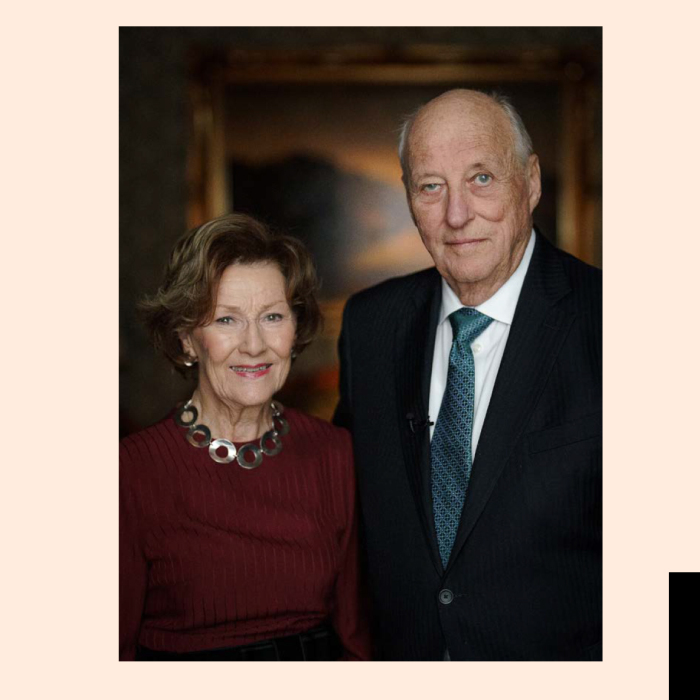Vsited Easter Island
During the Easter holiday this year, Their Majesties The King and Queen visited Easter Island in the South Pacific Ocean. The Norwegian explorer and scientist Thor Heyerdahl was instrumental in bringing this isolated island to the attention of the world. Today, 6 October 2014, marks the 100th anniversary of his birth.
In the 1950s, Thor Heyerdahl led the first serious archaeological expedition to the island with the distinctive, giant stone statues. The expedition had the Royal patronage of then Crown Prince Olav.
"It was an amazing experience to travel to Easter Island. The island was magnificent. When Thor Heyerdahl was there, it was brown with almost no green grass or any trees. Now is it a completely different island. It was lush and beautiful with many trees," said King Harald about his visit to Easter Island.
"A fantastic storyteller"
The King and Queen have had a longstanding wish to visit Easter Island.
“We had read Thor Heyerdahl’s book "Aku-Aku" about the expedition. In addition, Mr Heyerdahl spoke a lot about Easter Island when we were together. He was a fantastic storyteller. Sitting down at the table with Mr Heyerdahl was like setting out on an adventure,” said the King.
The book "Aku-Aku: The Secret of Easter Island", published in 1957, dealt with Thor Heyerdahl’s expedition to Easter Island. Three years later the documentary film of the same name was released. King Harald met Thor Heyerdahl numerous times and described him as energetic and a convincing speaker.
"He may not always have been right, but he made people think. He approached problems from a completely different angle from everyone else, for instance by reading source material literally. Thor Heyerdahl is still a prominent figure on Easter Island. The people there admit that not everything he said was correct, but they are grateful that he brought attention to their island," said the King.
The giant statues on Easter Island
Easter Island is best known for its stone statues known as moai, which are found throughout the island, primarily along the coast.
"The sculptures are a sight to behold. We saw them for the first time at dusk and we were completely alone. It is fascinating to think about how they moved these statues. The question is whether they bit off more than they could chew. The largest statue, which they did not complete and had not begun to move, weighed many tonnes. It looks like they stopped producing the statues overnight," said the King.
There are about 900 moia statues on the island. It is uncertain when they were erected. The statues stand up to 20 metres high. Most were cut from the volcanic crater Rano Raraku. The most widespread theories postulate that the statues were erected in honour of the inhabitants’ ancestors or important persons.
Isolated South Pacific island
Located in the southeastern Pacific Ocean, Easter Island is one of the world’s most isolated land masses. The closest inhabited land is Pitcairn Island, 1 600 kilometres farther west. In 2012 the island had approximately 5 800 inhabitants, and today it is under Chilean rule. Easter Island has been included on the UNESCO World Heritage List since 1995.
The first European to visit the island was the Dutch explorer and admiral Jacob Roggeveen, who landed on the island with three ships on Easter Day in 1722 – thus the name Easter Island. At the time there were 3 000 to 4 000 people living on the island. The history of the island is known from about AD 400. Thor Heyerdahl launched a theory that Easter Island was populated from South America. This view has little support today since linguistic and DNA analyses show that the people of Easter Island share a common ancestry with other Polynesian populations.
100th birthday of Thor Heyerdahl
This evening the King and Queen will be in attendance at a banquet at the Kon-Tiki Museum in Oslo to mark the 100th anniversary of the birth of Thor Heyerdahl.
Current news

The Crown Prince in the US
His Royal Highness Crown Prince Haakon concluded a four-day visit to the US Thursday. The visit went to the states of California and Washington, and several hundred Norwegian business actors accompanied him on the journey.

The Royal Court has submitted its annual report for 2023
The activities of the Royal House of Norway over the course of the year are closely aligned with the current situation in the country.

 Enlarge
Enlarge









